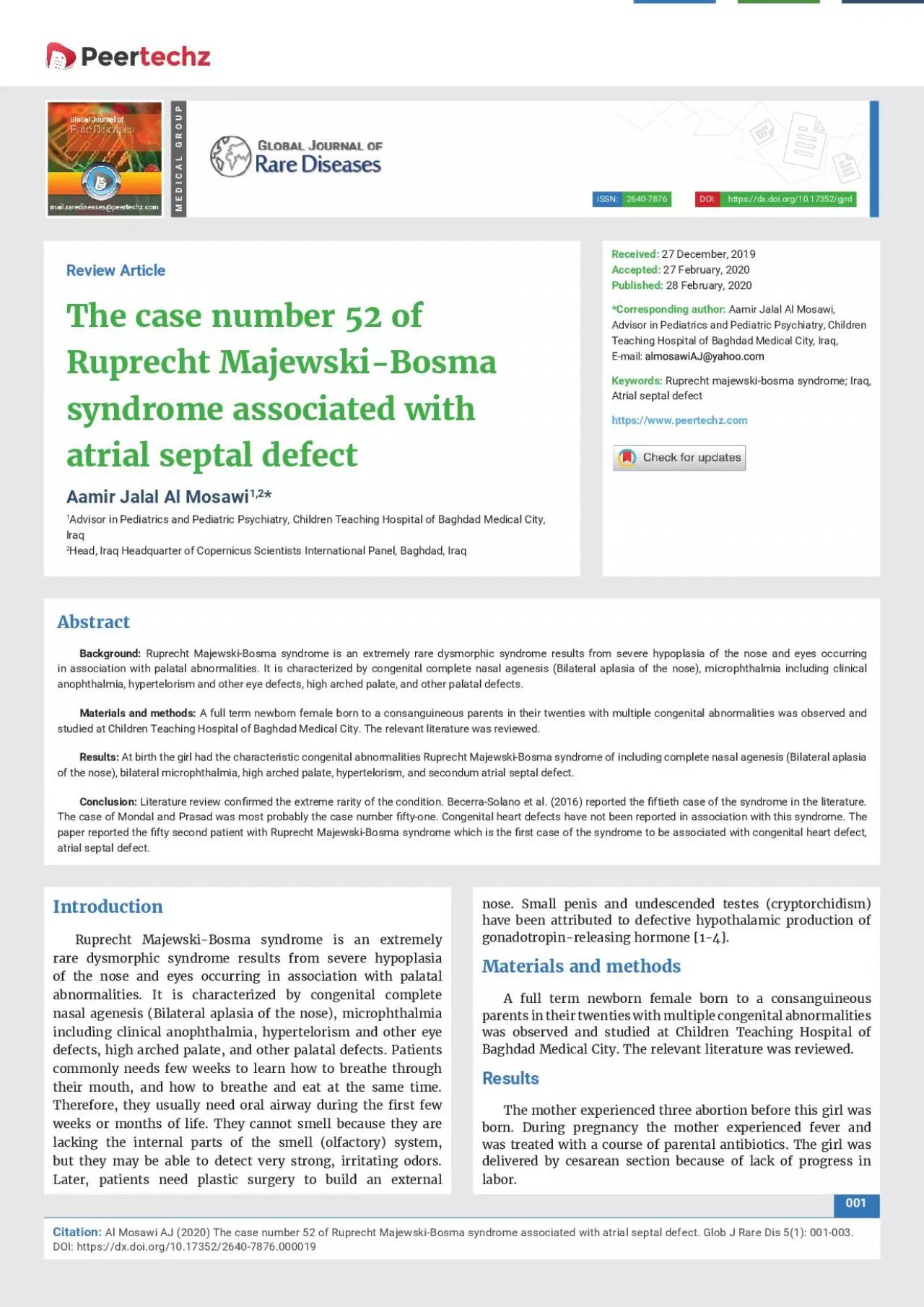

is 51 001003 nose Small penis and undescended testes cryptorchidism have been attributed to defective hypothalamic production of gonadotropinreleasing hormone 14 A full term newborn fe ID: 938074
Download Pdf The PPT/PDF document "Patients rst few" is the property of its rightful owner. Permission is granted to download and print the materials on this web site for personal, non-commercial use only, and to display it on your personal computer provided you do not modify the materials and that you retain all copyright notices contained in the materials. By downloading content from our website, you accept the terms of this agreement.
is 5(1): 001-003. Patients rst few nose. Small penis and undescended testes (cryptorchidism) have been attributed to defective hypothalamic production of gonadotropin-releasing hormone [1-4]. A full term newborn female born to a consanguineous parents in their twenties with multiple congenital abnormalities was observed and studied at Children Teaching Hospital of Baghdad Medical City. The relevant literature was reviewed. The mother experienced three abortion before this girl was born. During pregnancy the mother experienced fever and was treated with a course of parental antibiotics. The girl was delivered by cesarean section because of lack of progress in labor. Ruprecht Majewski-Bosma 1,2* Advisor in Pediatrics and Pediatric Psychiatry, Children Teaching Hospital of Baghdad Medical City, Iraq2Head, Iraq Headquarter of Copernicus Scientists International Panel, Baghdad, Iraq Aamir Jalal Al Mosawi, Advisor in Pediatrics and Pediatric Psychiatry, Children Ruprecht majewski-bosma syndrome; Iraq, https://www.peertechz.com/journals/global-journal-of-rare-diseases is 5(1): 001-003. 1. Complete nasal agenesis (Bilateral aplasia of the nose) culty in breathing requiring the use of 2. Bilateral microphthalmia (Figure 1).3. High arched palate (Figure 1).5. Low set ears.6. Large size aneurysmal secondum atrial septa
l defect. In 1978, Klaus Ruprecht and Frank Majewski described two German sisters with congenital complete absence of the nose and eye defects, choanal atresia, microphthalmia, and cleft palate. The parents were healthy, and Ruprecht and Majewski suggested that the two girls had a new autosomal recessive malformation syndrome [1].In 1981, James Bosma, a pediatrician studied two unrelated males reported previously in 1972 by George Gifford, a plastic surgeon and colleagues. Gifford and colleagues reported two cases with congenital absence of the nose and anterior nasopharynx. When Bosma et al. (1981) described the two patients of and colleagues, they reported that the also had rst trimester of pregnancy. The patients had normal The girl had complete nasal agenesis causing di culty in breathing requiring the use of airway piece and orogastric tube feeding. At the age of six months, it was to remove the airway piece and oro-gastric tube with establishment of normal breathing. https://www.peertechz.com/journals/global-journal-of-rare-diseases is 5(1): 001-003. © 2020 Al Becerra-Solano et al. (2016) reported a 19-month-old Mexican boy with congenital absence of the nose, bilateral clinical anophthalmia, choanal atresia, high palate, small penis, undescended testes, and hypoplastic scrotum. Becerra-Solano et al. co
nsidered their patient to be the Þ ftieth case of rst reported Mexican rst reported Mexican Mondal and Prasad (2016) from India described a male newborn delivered at term via uncomplicated vaginal delivery and had complete congenital absence of nose, bilateral microphthalmia, lower eyelid coloboma, and feeding difÞ culty. fty- rmed the extreme rarity of the ftieth fty-one. fty second patient rst 1. Ruprecht KW, Majewski F (1978) Familiary arhinia combined with peters 2. Gifford GH, Swanson L, MacCollum DW (1972) Congenital absence of the 3. Bosma JF, Henkin RI, Christiansen RL, Herdt JR (1981) Hypoplasia of Link: 4. Muhlbauer W, Schmidt A, Fairley J (1993) Simultaneous construction of an 5. LaTrenta GS, Choi HW, Ward RF, Hoffman L, Neidich JA (1995) Complete nasal 6. Thiele H, Musil A, Nagel F, Majewski F (1996) Familial arhinia, choanal atresia, Link: https://tinyurl.com/7. Olsen OE, Gjelland K, Reigstad H, Rosendahl K (2001) Congenital absence of Link: 8. Hou JW (2004) Link: 9. Graham JM, Lee J (2006) Bosma arhinia microphthalmia syndrome. Am J 10. Brasseur B, Martin CM, Cayci Z, Burmeister L, Schimmenti LA (2016) Bosma 11. Becerra-Solano LE, Chacon L, Morales-Mata D, Zenteno JC, Ramirez-Duenas Link: 12. Mondal U, Prasad R (2016) Congenital Arhinia: A Rare Case Report and Link: https://tinyurl.com/uagrq